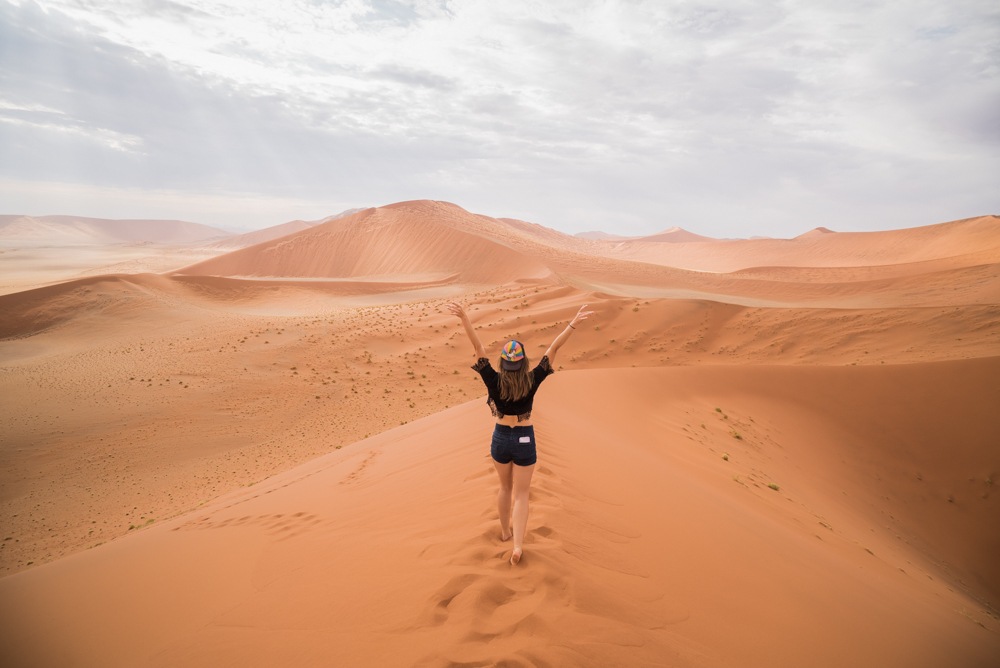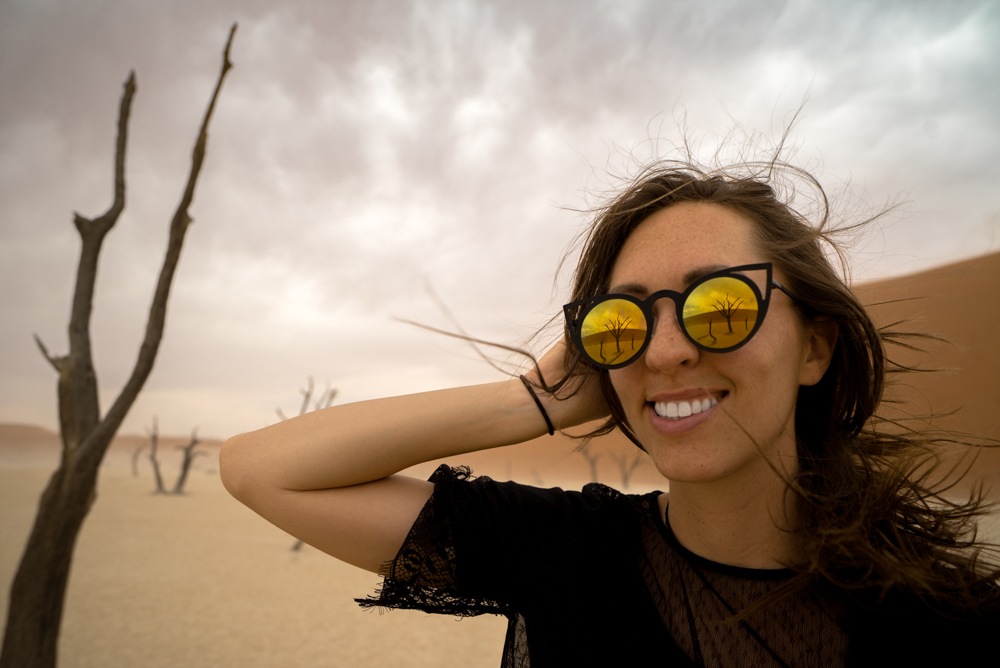Sossus means “place of no return”. Looking out at those gorgeous endless dunes with the bright blue sky and the vast expanses in every direction, it is easy to see why. Once you see this for yourself you’ll never be the same.
Namib-Naukluft National Park is one of the most popular attractions in Namibia, with the highest sand dunes in the world, the photogenic Deadvlei full of tree skeletons, and a massive salt pan known as Sossusvlei . In many ways it seems like it’s not even Earth anymore.
Located in Namibia’s largest protected area, Sossusvlei is a must-see, although it’s easier to enjoy if you have some key info. Here’s everything you need to know about visiting Sossusvlei:
How Sossusvlei and Deadvlei were Formed

Sossusvlei is a salt and clay pan that was created by the Tsauchab River that flows through the Sesriem Canyon every 5-10 years. The river does not reach the Atlantic Ocean even during the wet years, but drains away between the dunes.
The famous scorched acacia trees in Deadvlei had the chance to grow when the river previously flowed through the area, however, due to a drought, all of the trees died. Since there was not enough moisture for the dead trees to decompose, they remain perfectly preserved, standing for over 900 years now, and possibly for centuries to come.
Must-Sees

What is there to see? So much, my friends!
Dunes:
- Dune 1: The dunes are named for the number of kilometers traveled between them, starting with Dune 1, which is popular for photographers due to its perfect S shape. Stop by on the way to Dune 45.
- Dune 45: The most popular dune for sunrise, standing at 260 feet high.
- Big Daddy: The highest dune in the park, Big Daddy, reaches over 1000ft and is among one of the highest dunes in the world. This dune takes you high above Deadvlei and descends down into the salt pan. It’s one of my favorite things to climb up then run all the way down the dune. The sand feels so soft and it squeaks!
Deadvlei: In order to make it to Deadvlei, you’ll want a 4 x 4 vehicle to get through the sand. Most people who visit ride in one of the park’s vehicles which run regularly from the end of the paved road and take you right up to Big Daddy and Deadvlei. The hike up Big Daddy takes roughly 45 minutes, and you’ll want to leave an equal amount of time to wander around the trees at Deadvlei as well.

Wildlife: Although the desert conditions are harsh, there is a delicate ecosystem with a surprising amount of life living around and underneath the dunes. You may find snakes, geckos, hyenas, scorpions, hoofed Kudu and Oryx, and interesting insects. So be mindful when exploring or driving in the area.
Sunrise: If you possibly can stay in the park, do so because it’s the only way to see the sunrise from within the park boundaries. Otherwise, you can queue up and head in just after the sun rises when the park gates open. Park entrance fees are 60 Namibian dollars per person.
Unfortunately the options within the park are either a lodge that books up quickly and gets expensive during high season, or camping. There’s more info in the ‘where to stay’ section below so you can weigh your options.
If you’re self driving, this is a helpful area map with suggested driving and hiking routes.
What to Wear

After two trips to Namib-Naukluft National Park I’m convinced that the best footwear for climbing the dunes is none. I spent the entire time on both trips barefoot, finding that in the early morning the ground was not too hot yet and it just made it easier to get up and down the dunes. Shoes usually take on too much sand and will end up weighing you down, although if you are uncomfortable with the idea of going barefoot, socks are a good alternative.
READ NEXT: the perfect Namibia packing list
Also, remember the great rule of climbing dunes: Let someone else go first, and always walk directly in the footprints of the person who went before you. It is so much easier!
Otherwise, bring clothing that you can climb dunes in – I usually opt for a short sleeved shirt and shorts – along with a hat, sunscreen, and enough water for the day. You’ll be able to buy it at the park entrance but not thereafter.
When to Go

The best time to enjoy the park is as early as possible in the morning. If you are staying within the park boundaries and you can get to Dune 45 for sunrise, get your fill there and then head immediately to Big Daddy to start climbing before it gets blistering hot. If you can’t get to Dune 45 for sunrise, don’t despair as the crowds thin out shortly thereafter and you can get it all to yourself if you wait a bit to hike up.
That said, chances are good you will want to leave the park by midday because it simply gets too hot to enjoy by afternoon. You can always head back for golden hour to get smaller crowds and equally beautiful colors.
Where to Stay Within the Park
If you want to stay in the park for sunrise, your only options are Sesriem Campsite and Sossus Dune Lodge. Sesriem Campsite is the only campsite available inside the park, right beside the gate. This is the only campsite that allows visitors to get in the park an hour before sunrise and an hour after sunset, when the inner gate opens and closes. Facilities and service are basic, though there is a pool which is great after a long day under the hot sun. If catching the sunrise and sunset, and being the first group of people there are your priorities while on a budget, definitely stay here. Be sure to book in advance!
(The campsite will be increasing their prices from $15 per night to $24 per night in 2019. More information on the pricing here.)
Sossus Dune Lodge is an eco-friendly, luxurious accommodation offering 25 chalets with direct views of the dunes, and 12 chalets with a view of the mountains and the Sesriem Canyon. Similar to Sesriem Campsite, the location of the lodge allows visitors to access the park before everyone else in the morning, and after everyone else in the evening. Expect to pay $140 – $300 per night. More information on the pricing here.
Where to Stay Outside the Park
Desert Camp is a quick 5 minute drive away from the park entrance and where I stayed with my BMTM Adventures group. The camp has amazing night sky views, standalone bungalows, a decent pool, a wooden bar, and great facilities. You can use their BBQ facilities, or travel 5km to the Sossusvlei Lodge for an amazing dinner, which is what we did. Expect to pay about $80 – $100 per night.
Sossusvlei Lodge is just 1 minute from the gate so it’s really as good as it gets. The luxury lodge has amazing online reviews, with people suggesting to extend your stay, as you are likely to arrive late in the afternoon on the first day, leave early for sunrise on the next day and not come back until evening. Stay one more night so you can enjoy the amazing facilities and great food Sossusvlei Lodge has to offer. Expect to pay about $300 per night.
Getting There
Unfortunately, the roads heading to Sesriem are unpaved, gravel roads. Most people travel there via the capital, Windhoek, or Swakopmund. Be prepared for washboard roads and gravel for about 4-5 hours from either starting point.
It is doable in a non-4 x 4 vehicle, though if you plan on heading off the beaten path in Namibia and self driving in Etosha, you may want one anyway. Make sure you’re equipped to change a tire just in case.
Finally, don’t forget to look up at night. Namibia has some of the best star viewing on Earth and the Namib desert is dry enough to provide some crystal clear viewing, followed by a beautiful day running around the dunes. Enjoy it, this is one of the best experiences in Africa!

Leave a Reply